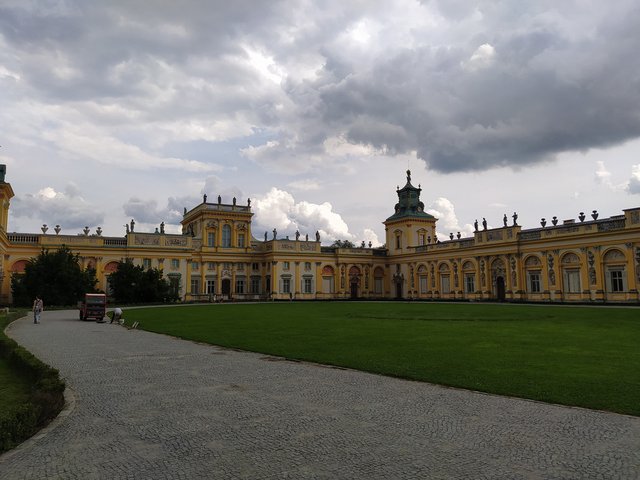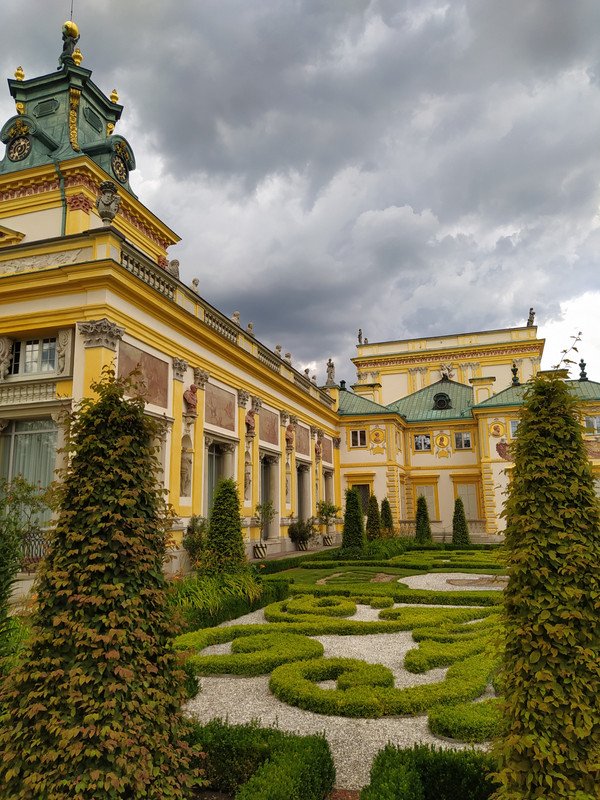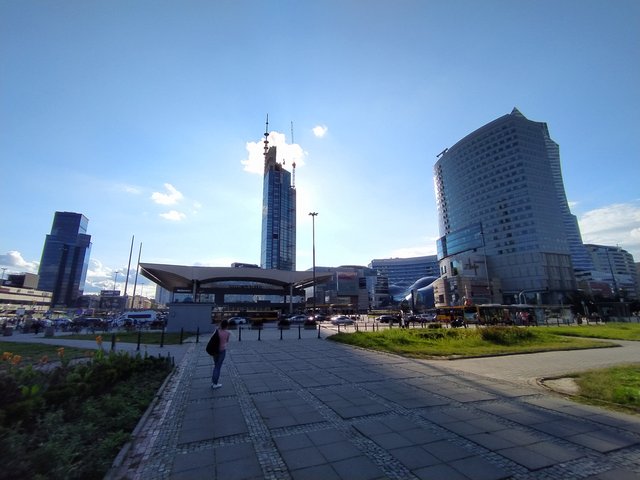Joonto's Travels: Warsaw I
I've always considered Warsaw a fascinating place to visit. My cousin told me wonders about this city. In this moment of my life, I'm even looking for a new place to live. I have left my job and I'm tired of living in Malta. I miss big spaces, I miss green and I miss to be surrounded by crowds of strangers. I want to experience the big city life. That's how Warsaw came into my route of this long journey, which I hope, will drastically change my life, possibly for the better. In this two parts article, I will show you what you can visit in Warsaw and how living in Warsaw might look and feel like.
This first part is focused on sightseeing, while the second part will take a closer look at what you can do in Warsaw and how to live there. Let's start this wonderful tour then! First stop, at what used to be the summer residence of the Polish kings!
Wilanow Palace
If you come to Warsaw in search of something historical survived to the madness of war, you may want to visit Wilanow Palace. The palace was built by King Jan III Sobieski. He is mostly notable for having led his Polish army, along the Austrian army, in the Battle of Vienna, defending the Austrian capital against the Ottoman Empire's siege. That was an attempt from the Turks to invade, not only the Austrian Empire, but the whole European continent. For this, Jan III is regarded as a savior of Christendom and the Western civilization.

Warsaw used to be called “the Paris of the North” and the reason becomes obvious when you reach the Wilanow Palace. The residence resembles Versailles, though it embodies many elements and styles taken from other schools, mixed in an original Polish way. The gardens are simply majestic, embellished by that elegance typical of the 17th century.
When you walk through the gardens, you are taken right away by the beautiful colors which permeate the residence, from the flowers to the fine decorations of the palace facades. The artists made good use of yellow, so that the buildings look as if covered with pure gold.


Of course, you will find a lot of green, as it is expected by a royal residence. You can enjoy a nice walk through the boulevards and maybe reach the lake, where you can bump into some cute friends.

After all this green feast, I was eager to see the wonders hidden in the palace, but I couldn't find any entrance. I realized I was going to miss this when I crossed the gate for the exit. I got in again, passing by a guard. The cop shouted at my back: "ticks, ticket!"
Here is the ticket.... He spoke Polish only, so he couldn't help me figure out if the place was closed for good. Well, if you work at Wilanow Palace you should speak some words of English. There's so much unprofessionalism in the world.
Eventually, after some laps around the gardens, I found two women working there. They gave me the sad news that the palace is open only from Thursday to Sunday. The other days, only the park is open. That was a pity, but in the end I accepted the verdict.
Old Town (Stare Miasto)
If you go to Warsaw, you cannot miss the Old Town. Now, the Old Town is not really old, it is a reconstruction of what it used to be before the Nazi blew up every building, during their coward retreat in 1944. The reconstruction was an incredible feat that deserves praise. Most of the original bricks and material was taken from the debris and put back into their original places.
Polish restorators started from this:

To make this:

It's also because of this massive effort, on top of the intrinsic beauty of this place, that the UNESCO signed the Warsaw Old Town into the World Heritage Sites list!
The Old Town is the perfect place if you want to breath the classic historical air you breath in other European capitals.

While walking the narrow streets, you will notice many amber shops. Amber has always been an important source of trade for Poland. Probably, you won't find any amber containing dinosaur DNA, but surely you can stop at a shop if you have in mind a special present for your loved ones!

All the streets converge into the Market Square, as it is expected from a medieval town. At the center, the Mermaid, symbol of Warsaw, will watch you. Maybe she is trying to warn you from sitting at the several cafes and restaurant placed in the square. They are clearly tourist traps, don't sit there. As you walk away from the square, you will find many interesting places. I can't suggest you any, because I wasn't hungry when exploring the area. I ended up at The Alchemist.

How come that a mermaid is the symbol of an inland city? There is a moving story behind this symbol. The legend tells the story of a mermaid who started swimming up the Vistula from the Baltic sea. When she got tired, she rested on the sandy Vistula banks. She liked the place so much that she decided to live there. At the time, Warsaw was a mere village, which people lived mostly by fishing in the large river. The mermaid became a problem for the fishers, as she loved to play tricks on them, like sabotaging their nets. The men were determined to get rid of the pest, but when they managed to trap the mermaid, she started singing a song which moved all the animals in the river and eventually the fishermen themselves. The story continues with a vile merchant who captures the mermaid to display her as an attraction. The fishermen's kids release her, killing the merchant and in return, the mermaid promises to watch over the fishermen for the rest of the days.

Before hitting the Old Town, I suggest you to hit Ogród Saski. It is a beautiful park which hosts the Tomb of the Unknown Soldier, a memorial to all the Polish soldiers fallen in the wars. It is always guarded by two soldiers, standing in respectful stillness. Other remarkable spots are the big fountain right behind the tomb and the smaller fountain of the Boy and the Swan.
Here you will see many cute birds, from ducks to giant ravens. These ravens are so big and smart that you may think they are humans reincarnated as birds! Their thought is so evolved that they are capable of putting nuts on the railway and wait for the train to break the nuts from them! Astonishing!


Powązki Cemetery
Let me confess my most sinister passion. I love cemeteries. It sounds weird, right? No, I'm not a necrophile! Cemeteries have more interesting aspects than corpses. You can find amazing architecture in a holy field. Tombs are masterpieces of craftsmanship that you rarely see even in the most elegant buildings! When it comes to Warsaw, this aspect stands out even more, as buildings here are normally ugly, anonymous, even those ones build after the end of communism. Architecture is the real weak point of Warsaw, so if you want to see some beautiful structure, come to Powązki Cemetery!

This very cemetery is inspiring. Powązki Cemetery hosts many famous Polish personalities like poets, musicians or painters. If you will pay a visit, you will understand better what I felt there. I could spend a whole day in this park!

Polish Army Museum (Muzeum Wojska Polskiego)
I spotted this museum by chance, while taking night photos. My eye was caught immediately by the airplanes parked outside the museum premises. When I checked the timetable outside, I noted Thursday on my calendar. Why? Because on Thursday, entrance is free!

As you walk the gate, you will see aircrafts, tanks, cannons, heavy vehicles and more aircrafts. The adult in you may horrify at this vision, thinking what these tools are used for, but the child inside you may well be enthusiast.

The entrance to the interior was busy of course, because it was free day and because of COVID-19, only a certain amount of people were allowed at once. I think I waited for something like 20 minutes standing in line, but it was worth it. The museum is well furnished and not so big. You can check everything in one hour. I took two, because I like reading the descriptions and imagining how the artefacts were made and used.
The most entertaining part is the medieval section. I didn't imagine they used to fight wearing wings made out of feathers! The outlook of this knight is something between the Native Americans and some weird warriors seen in Flash, the worst movie ever...

The museum also taught me there used to be armors with... mustaches! Look at this guy!

War is horrible, but weapons are fascinating!



Warsaw 1944 Uprising Museum
Warsaw, 1st of August, 1944. The Polish resistance, through the Home Army, gathers all the courage possible and rises against the Nazi occupiers. It's time for an Uprising, for the Powstanie Warszawskie! The operation is timed to coincide with the arrival of the Soviet forces, which have already been pushing the Germans out of East Poland. However, the cold calculator at the helm of the Soviet Union, Joseph Stalin, has already in mind a more pervert plan to bend both the Germans and the Poles in one shot. He lets the two factions fight each other in one of the bloodiest battles of War World II, where all the possible violence unravels unchained. Unaware that they will fight alone, every young Warsaw citizen joins the Home Army and goes in the streets to fight the Nazis. Polish flags are waved from the buildings once again for the first time in 5 years. The bells are ringing to call for rebellion. It's the culmination of the hard work of the Polish Home Army, which over the 5 years of Nazi occupation, plotted underground operations of sabotage, leaving the Germans in a never-ending tension and making them ever feel unsafe on Polish soil...
At the beginning of this battle, that will last 63 days, 30,000 Polish take part in the uprising. Only 10% of them start fully armed. Their opponents are 20,000 Germans fully armed.

The Nazis retaliated with an unprecedented violence, which increased proportionally to Polish resistance. This violence culminated in the killing of every resident left in Warsaw and the destruction, building by building, of the Polish capital. Not even the historical buildings were spared by the Nazi fury. Himmler had been craving to burn a city to the ground for so long, but he had never had the opportunity before. Himmler amused himself with Warsaw mostly because the city used to host the biggest Jewish community in Europe and so he was craving to “wash” it away from the face of Earth.

The museum projects a short film showing the devastation left by the Nazis and it reminds us that Warsaw used to have 1,300,000 residents before the War. When the Soviets entered Warsaw, then reduced to a desert of debris, the people left were about 174,000, a mere 14% of prewar levels.
Unluckily for Himmler, the Polish spirit didn't break and the Warsaw citizens managed to rebuild their city, including the historical center.

When you enter the museum, you are welcome by a chaotic entrance. The chaos is intentional. This is a reconstruction of Warsaw streets during the Uprising. As you can expect, you see graffiti venting against Nazi and inciting to rebellion, to resort on the Polish national pride. There are several artefacts protected by the glass, like guns, spy devices, even a jar of marmalade, which could save lives in those extreme conditions of deprivation. You can read the personal stories from those days, you can peer through binoculars installed on the walls that will show you the inhumane conditions of the Jewish ghetto. When you are reading those incredible stories you'll notice that sound capable of giving you the chills out of fear and excitement. It's a deep, strong and loud heartbeat. It's an 8 minutes sequence of a heartbeat, accompanied in the background by war sounds: planes, bullets, collapsing buildings. If you're empathetic, it will be very easy to imagine what those people were going through. On video, you listen to the survivors, just kids or teenagers back then. You can get how in their young minds, fear was quickly overwhelmed by excitement, by that indescribable hunger for freedom. Jan says: "When I told my parents I was going to the Uprising, my dad agreed and he said – OK, go, it's what you feel like. Just don't be killed in a stupid way. Don't try to escape. Stand till the end. Just don't do something stupid."

As you climb the stairs, the heartbeat slowly fades, but its powerful message continues. Upstairs you can see German machine guns, uniforms and other incredible tools. These were used also by the Polish Home Army, when they defeated the Nazis in battle and took the weapons away from them. In the second floor, you can learn about the saddest part of the Uprising; once the treaty was signed with the Nazis, the Polish Home Army retreated on the other side of the Vistula, where it was "welcomed" by the Red Army. In a few hours, the Soviets decided to execute all the Polish officials. Imagine the situation. You fought hard for your country, against an enemy way better equipped and experienced than you. You are in your 20s, still with an entire life ahead. You lost most of your friends, maybe even your parents. You may have been wounded, but you kept fighting for a right cause. You made through it, wounded, depressed, stressed, starving. When you can finally rest, who was supposed to rescue tells you that you are going to die. Not even on the spot, but with a formal execution that will give you all the time to think how life is bad, unfair, ironic. To think that there is no justice, no God, no higher power. To think that all you did was useless. To think that in the world you can't trust anybody. To simply wonder, why???

When people say "Everything happens for a reason", I hate them outright. History taught us very well, that nothing happens for a reason. Doing well will not protect you from evil, probably it will put you in a bigger danger. The truth is that the pursue of what's right, transcends your personal existence. The best definition probably comes from Polish insurgent Juliusz Kulesza "Julek":
“What was the most important thing about the Rising to me? It was selflessness, because people follow reason in the so-called normal life. And what could a girl expect when she was crawling across a street under machine gun fire to get to a wounded person? She could expect nothing but a bullet to her head. And she was not deranged or insane, not at all. She was a regular person. So, there are situations in life, or in history, pompously speaking, that can muster the best of human attributes in us.”
This quote is written in the long description of what is the most intense art installation I've ever interacted with before. Its name is "I am like you, surely". It is a special mirror. The mirror says “Do you have the courage to see... your Uprising reflection?”
When you look in the mirror, a face will slowly take shape, the face of someone who fought during the Uprising, possibly someone who resembles you. The effect makes you shiver. The message is clear and powerful: we are all humans, after all.
I guess the installation is powered by a face recognition AI. It's really about courage, as face recognition is the kind of algorithm I fear the most. It's nice to see this diabolical technology, conceived deliberately for mass surveillance, used in an artistic way. After all, there are sculptures made out of guns. It's true that you can do art with everything!
TO BE CONTINUED...
*No Grammarly used

Congratulations @joonto! You received the biggest smile and some love from TravelFeed! Keep up the amazing blog. 😍 Your post was also chosen as top pick of the day and is now featured on the TravelFeed.io front page.
Thanks for using TravelFeed!
@for91days (TravelFeed team)
PS: Have you joined our Discord yet? This is where over 1000 members of the TravelFeed come together to chat. Join us!